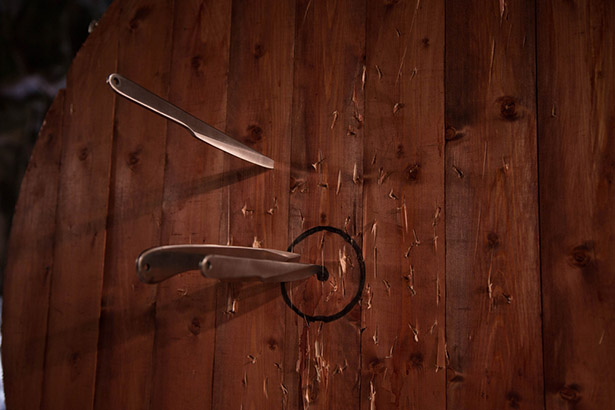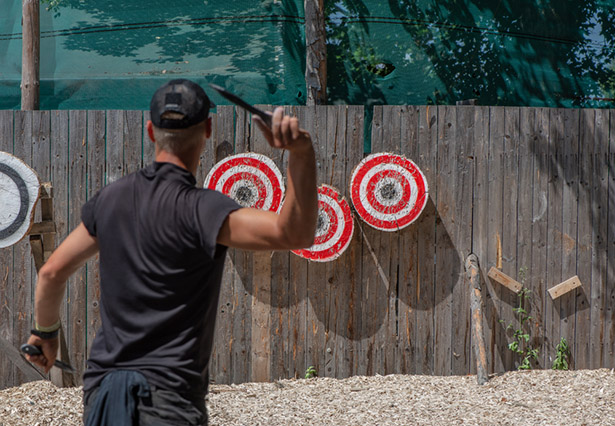Bullseye! Learn How to Throw Pocket Knives
Mar 21st 2019

Knife throwing is a sport that's practiced by many people. It's similar to darts or ax-throwing and has even been featured prominently in films, television shows, and live performances.
Throwing knives that aren't meant to be thrown can damage them, but pocket knives are a good option. An EDC fixed blade knife is preferable to a folding knife because it doesn't fold and is typically easier to throw.
1. Select your knife
Throwing knives don't need a sharp blade because a pointed tip will penetrate your target. The best pocket knife for knife throwing is simple. A design on the handle or blade might look cool, but it may catch your hand in the release.
You also need to consider weight distribution. There are three different types of weight distribution for knives: Handle-heavy, blade-heavy, and balanced.
Professional throwers use a balanced knife because they have better control over the trajectory and their impact on the target. A balanced knife can also be thrown by the handle or the blade, depending on your preference.
If you are just getting started in the sport, you may find it easier to use a blade-heavy knife because you won't experience as much hand fatigue. In contrast, handle-heavy knives are considered more challenging to get used to because the trajectory is less predictable.
The weight of the knife and the throwing speed also affect the impact on your target. Lighter knives may wobble in flight and fail to penetrate the target, but more strength is required to throw heavier knives.
When choosing a knife, pick one that feels right for you and one that you can throw safely. Fixed blade knives with a sheath protect the blade and keep you safe when transporting it.
2. Select a location
The location for throwing pocket knives is important because you want to avoid any obstructions. In your area, you may find an indoor or outdoor blade throwing range, but you can also set up targets in your backyard or basement.
Ensure proper safety by establishing your knife throwing area away from places where other people, children, or pets spend their time. Be cautious of what is behind your targets and ensure there is a proper barrier such as a fence.
Although the target can be adjusted according to personal preference, it's recommended that beginners place the target at a 10-15-foot distance.

3. Stance
First, stand with your feet in a straight line and at a shoulder's width apart.
How you hold your knife depends on the weight distribution. Grip a handle-heavy knife by its blade and a blade-heavy knife by the handle because unbalanced knives are typically thrown by gripping the lighter end. Those using a balanced knife can grip either the handle or the blade, depending on personal preference.
Next, bring the foot that's on the same side on your dominant hand back until your toes are parallel with the heel on your other foot.
When throwing the pocket knife, your weak-side shoulder should be facing the target. In other words, if you're right-handed, your left shoulder should be facing the target. Point your non-dominant hand at the target as well.

4. Throw the knife
The conventional way to hold a fixed blade knife while throwing it is to keep your thumb on the edge of the blade or handle so that you can throw it vertically. This is called the Hammer Grip.
However, an unconventional method that throwers may feel is more natural requires them to hold the knife on the flat of the blade or handle by positioning their index, middle, and ring fingers in the center on one side (with the pinky finger extending past the flat). Their thumb rests on the center on the other side. This allows them to throw the blade horizontally.
When throwing the pocket knife, raise your arm until the knife is positioned behind your head. Avoid moving your wrist during the motion and affecting the trajectory.
While taking a step forward, throw the knife as hard as possible toward the target in a quick motion. Release the pocket knife as it comes down. Your arm should be fully extended. Just like a baseball, follow through on the throw. When releasing the knife, continue to avoid wrist movement.
Final Thoughts
Throwing knives accurately and safely is a test of concentration, practice, and skill. However, the most important factor is the knife you use. Though knife enthusiasts may seek a unique or one-of-a-kind throwing knife to add to their collection, a simple knife is best. Browse our selection of Microtech fixed blade knives,which are perfect for the sport of knife throwing.

